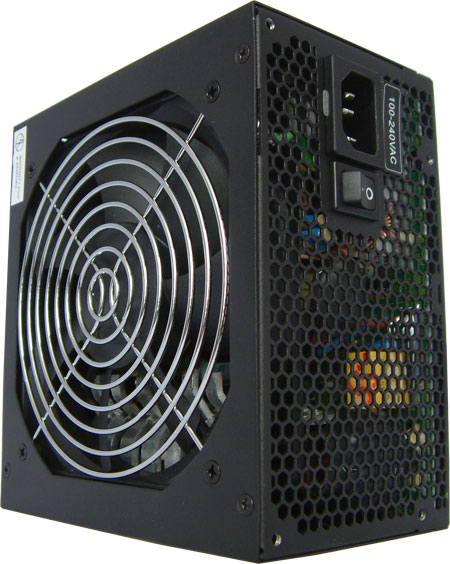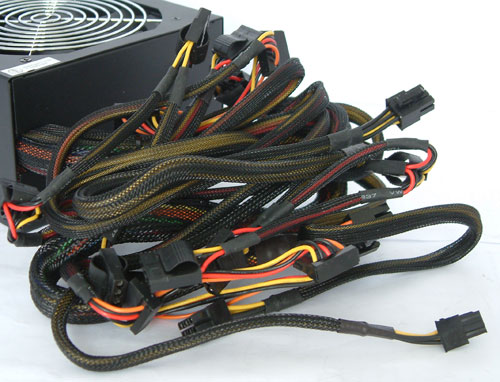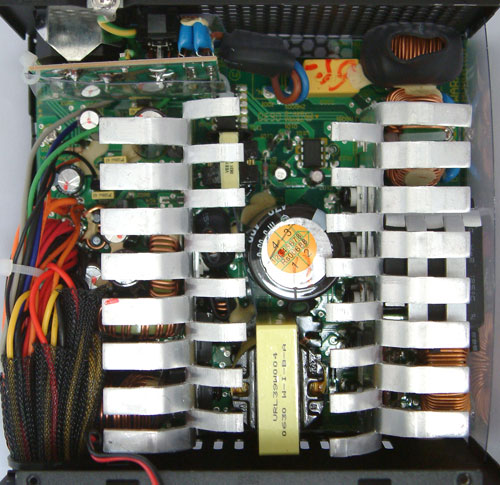Power Supply Roundup: 650W-680W
by Christoph Katzer on February 21, 2008 2:00 AM EST- Posted in
- Cases/Cooling/PSUs
Seasonic
Energy Plus SS-650HT

As one of the pioneers of the modern "planet saving movement", Seasonic's 650HT is a very aged power supply. Still, as stated Seasonic was one of the first companies to design energy efficient topologies, and they've earned respect from users all over the world. Coming in a standard black color with a silver fan grill, this unit doesn't look all that special, but that's Seasonic's modus operandi, and it has helped make them famous. Their first retail power supply - the Super Tornado in 2002 - came in plain grey in a day when colorful power supplies were all the rage. Seasonic ignored the fads and instead focused on high efficiency and high reliability for their products. The 650HT was one such product, first released a few years ago. Since many own these power supplies (or variations of this power supply), we felt including it in this roundup made sense.

Looking at the Seasonic label we see four 12V rails rated at 18A, with a total combined power of 52A. Recognize the pattern yet? The 3.3V and 5V rails both have the standard amperage and 170W combined power.

Being a little bit behind the current market trends has been a common feature of Seasonic, but since this fellow is already over a year old we won't criticize it for only including two 6-pin PEG connectors; besides, that's standard practice in the 650W range as we can see from the competition today. All cables are nicely sleeved with a decent length. Seasonic doesn't try to be different from the crowd, and the cables come with standard lengths of at least 50cm.

The inside is nice and sleek. Compared to the be quiet! power supply, the Seasonic Energy Plus seems empty and comes in a very short and compact case. Look closer and you can see that this design is also used in the PC Power & Cooling Silencer, though PC Power added components to the primary side. Seasonic also uses a 120mm fan, which is the major difference from some of their OEMs. The heatsinks need to let some air through, and Seasonic uses a standard heatsink design of a simple plate cut and bent into shape. It's one of the cheapest methods of producing heatsinks since the tooling costs of an extruded heatsinks are quite high, but Seasonic doesn't have a problem with high temperatures and this type of heatsink is sufficient for their needs. Channel Well also uses this method for some of their power supplies, but they don't leave enough space between the fins to let air through.










23 Comments
View All Comments
strikeback03 - Friday, February 22, 2008 - link
If you check various Anandtech articles their power draw charts are typically done with a Kill-a-watt meter at the wall. So multiply those numbers by approximately 0.8 and you will have an idea of what those components draw together from the PSU.I built a system for the lab here using an E2180, P965, 2x1GB DDR2-800, 1 DVD, 1 HDD. With a fanless 8500GT idly power at the wall was around 90 watts, I never cheacked load (card had issues). With an 8800GTS 640 idle power at the wall is about 135W, at full load around 210W. System is using an Earthwatts 380.
Christoph Katzer - Thursday, February 21, 2008 - link
Just check the diagram, a 650W unit needs to have at least 150 watts drawn before it has a decent efficiency. I was running a 4000+, 7800GTX, couple of drives and 2 gig of ram and didnt come over 150 watts fully loaded. So just imagine how low the actual power consumption is nowadays and how cool everybody looks with their 1000 watts unit which is drawing only around 150 watts with an efficiency of maybe just 70%.Before choosing a new PSU you would need to know the rough amount of power you need while operating the most used app on the PC. This is at most average PCs 100 to 150 watts and for that a 500-650W PSU is just the best choice.
Super Nade - Thursday, February 21, 2008 - link
Hi,How are you arriving at your numbers for regulation? What kind of a load are you using as "idle" to compute the percentages? Is it the manufacturer supplied minimum values or is it something you have chosen at your discretion? I hope you are not calculating stuff based on 12.00, 5.00 and 3.30 values!
Also, why did you guys drop the rail-wise load distribution charts and the cross-loading tests? That was quite informative and nice to compare units at a glance. These percentages do not convey as much information.
Another suggestion I have would be to use standard, yet very simple statistical calculations (mean, standard deviation, variance) instead of these percentages.
Best wishes,
Super Nade @ OCFoums
Christoph Katzer - Thursday, February 21, 2008 - link
We needed to cut some info to make the articles shorter, but I can get those back on next time.Griswold - Thursday, February 21, 2008 - link
... when we arrived at the more reasonable 400-550W range.Dont get me wrong, Christoph is doing a great job with these reviews but most if not all of them are for PSUs that are a wee bit too oversized for many people - even here at AT.
jonnyGURU - Thursday, February 21, 2008 - link
The problem is this community is very much divided when it comes to power consumption. Many people - even here at AT, may not be using SLI. The most decisive factor in power needs is what GPU you're using and how many of them you have. Given the current selection of SLI or Crossfire capable graphics cards on the market today, I would NEVER suggest anyone use a 400-550W power supply for any of them. Yes, you can run a pair of 8800 GT's off of a 500W for some time, but nobody thinks about the long term effects of running a PSU at 75%+ capability for extended periods of time inside a 40°C typical operating temperature.Of course, SLI and Crossfire is not the majority of the populus. Dual processor even less so, so you are correct in the statement that most PSU's are "oversized" for many people.
But that brings me back to the point Christoph made; "Most users don't need even 650W, but it's more difficult to find good quality PSUs in the 300-500W range." This is TRUE. Yes, the Antec EarthWatts 500W is "adequate," but you're fooling yourself if you think it's near the quality of a CWT built Corsair, Thermaltake or Xigmatek. It's not cost effective to make these higher wattage, higher quality units in lower wattages and then price them to be competitive with "it'll do" units like the low end Seasonics. Again, is the Seasonic adequate power? Yes. If not stressed over long periods will they last seemingly forever? Probably. But the better quality units are in fact in the higher wattage range.
yyrkoon - Friday, February 22, 2008 - link
Hi Jonny, Just going by what Christopher said, it would sound like a lot of systems could(possibly) not even come close to stressing a 500W PSU. I myself even bought a video card thinking of this(nv 7600GT). SO with an E6550 overclocked to 2.8Ghz, 2GB of DDR @ 2.0v, a CD/DVD burner, 7600GT , with 5HDDs how much power could I even be using ? Under a full load I doubt it would be much more than 300W, even if I had all my drives hammered at once(which never happens). Not only that, I use a reverse ATX case where the PSU sits on the bottom of the case, and draws air in from the bottom. Am I the norm ? Probably not, but I am sure there are many others who take all these things into consideration before building a system.Sure, hardcore enthusiasts who *must* have dual - quad GPUs will need lots of power, but I think if someone were to take an *accurate* poll, these users could not possibly make up for more than %5 of total computer users out there(and it is probably much lower than that).
Now, if you are THE Jonny Guru, I must say keep up the good work, I based my PSU buying decision partially on your review of the EarthWATTS 500. It has not let me down yet, and going from past experience, I doubt it will any time in the near future(for the next couple of years anyhow).
jonnyGURU - Friday, February 22, 2008 - link
Again, I never said that SLI or even a single high end graphics card is "the norm." No offense, but you only have a 7600GT. Not a high end graphics card and certainly not something that requires more than a 500W PSU. Heck... a 400W PSU. But that's what either Chris or I are saying: If you want a really good quality PSU, you can't usually find them in the lower wattage. It's simply not cost effective to spend $100 on the BOM to build a top notch PSU only to have to compete with other "it'll do" PSU's that sell for under $100!I didn't necessarily say that anyone NEEDS these high quality PSU's, regardless of wattage, but do people really NEED to drive Jaguars, Lexus or Infiniti? No. They don't. But if you WANT a high quality PSU, regardless of what you're powering with it, what's wrong with going out and getting a 650W, 800W or even 1000W to get that kind of quality? Who are we to tell people how to spend their money?
yyrkoon - Saturday, February 23, 2008 - link
Can not say I agree with your Car<->PSU analogy. A luxury car is not necessarily better, and in the case of Jaguar, there are several 'lesser' manufacturers who make twice the car, for half as much. I do understand what you meant, and mean by quality PSUs.Oh, and 'no offense' taken on the 7600GT, most people do not realize that if you're only playing on a 19" LCD @ 1440x900, that you do not NEED a freeking $500usd GFX card. It'll play just about any title fine, and most of the games I run are set at maximum settings. I also wont move to Vista, and Directx 10 anytime soon . . .
yyrkoon - Thursday, February 21, 2008 - link
Heh, sorry couldn't resist, although I suspect the Antec was manufactured by Seasonic, couldn't say for sure on the others. Anyhow . . ." Most users don't need even 650W, but it's more difficult to find good quality PSUs in the 300-500W range, "
Antec EarhWATTS 500, using it myself, works very good, and is manufactured by Seasonic(or so I have read). Its also selling for less than $50 at newegg last I checked. Seasonic also makes a nice 500W'rs I think.
You guys said something about Seasonic pioneering the no frills look, and efficiency etc, and they started building PSUs in 2002 ? No idea, but I've read that PC Power and Cooling has been around since the 80's, and these have been their 'trademarks'. Assuming what I am saying here is accurate, I find it funny that you would mention these things about Seasonic as though they were the original OEM to have this philosophy.